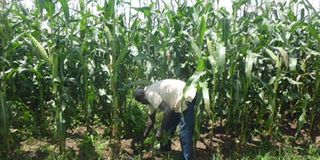Namulonge releases new maize, cassava varieties

Hybrid maize varieties at the trial site Namulonge. Photo by Lominda Afedraru
In recent years, agricultural scientists in East Africa have been breeding hybrid varieties to address a number of challenges faced by the farmers.
In the case of maize, there are diseases such as Maize Lethal Necrosis (MLN), which has been ravaging eastern Uganda and western Kenya. Other challenges include the effects of drought, pests such as stem borer, and Striga.
For cassava, the threats are viruses—Cassava Mosaic Virus (CMV) and Cassava Brown Streak Virus (CBSV)—as well as drought.
At National Crop Resources Research Institute in Namulonge (NaCCRI), the maize varieties recently released are, namely, Naro Maize-03, Naro Maize-56, Naro Maize-57. These are high yielding hybrids to address the problems of diseases and declining soil fertility.
Dr Michael Otim, the head of the cereals department, explains that Naro Maize-56 has features of being tolerant to MLN. Its yield capacity in farmer fields is eight to nine tonnes per hectare and it has a characteristic of staying green throughout the planting season. It can tolerant post flowering drought conditions and its maturity period is 135 to 140 days.
Naro Maize-57 is drought tolerant and can withstand low soil fertility with yield potential of six to seven tonnes per hectare and it matures in 125 – 130 days
Naro Maize-03 has traits of high yields as well as being resistant to common foliar diseases like Macicum leaf blight, grey leaf spot and maize streak virus, among others. Its yield potential is six to seven tons per hectare and matures in 120-126 days.
These maize varieties are mainly for the mid-altitude and the scientists are in the process of developing varieties for highland areas like Kapchorwa and Buikwe in eastern Uganda, which are major maize growing regions.
The team is also set to develop varieties, which will help in addressing issues related to aflatoxin. This is by developing varieties which will resist colonisation of fungus that cause accumulation of aflatoxin on harvested maize.
Daniel Bomet Kwemoi, a maize breeder at NaCCRI, pointed out that the researchers worked with International Maize and Wheat Improvement Centre.
It took the team five years to carry out the development process. Two years were spent on carrying out the crosses to get the parent lines and three years testing at different locations. The trial sites included Namulonge, Bulindi in Hoima, Ikulwe in Mayege, Serere, Ngetta and Bulegeni.
Usually, there is a huge yield gap between research stations and farmer fields. Bomet noted that this is mainly due to failure to observe proper agronomy practices by farmers.
In addition to the maize varieties, NaCCRI released two cassava varieties: Naro Cas1 and Naro Cas2, which are high yielding, aromatic, have a sweet in taste, can withstand pests and are rich in food matter.
The two varieties have a higher resistance to CMV and greater tolerance to CBSV.
These diseases are the biggest constraints to cassava production in Uganda. Statistics indicate that they can cause losses of up to $24.2m (Shs81.7b) annually.
When harvested and fresh from the ground, the new cassava varieties can yield 14 to 55 tonnes per hectare and root dry matter content of 31-36 per cent.
The two varieties have high levels of alcohol content, making them very suitable for use in commercial ethanol production.
In Uganda, ethanol is being used to make medicinal alcohol, alcoholic drinks, fuel and solvent. Ethanol produced from cassava is a better alternative to gasoline, promises cleaner combustion, promotes a healthier environment and is economically viable. The starch from cassava is also used in industrial sector to make, glue, animal feeds, paper, plywood and textiles.




